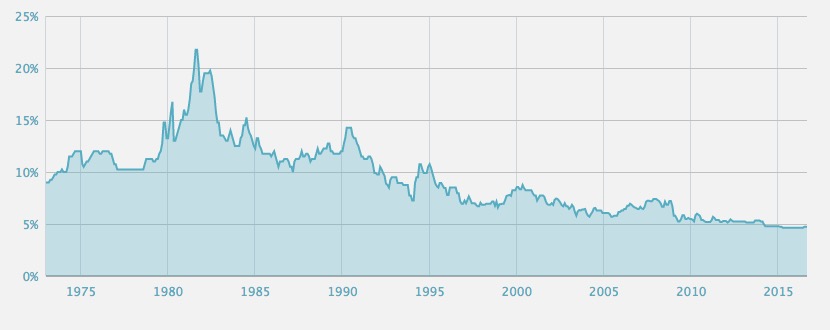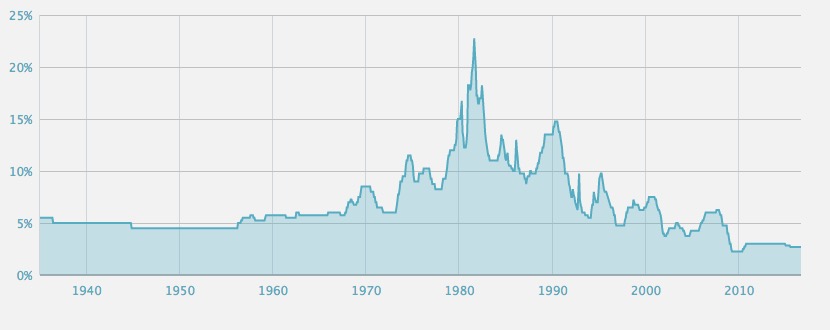With all the recent government activity meant to bring stability to the Canadian housing market (read cool down Vancouver and Toronto), its no surprise that the bank of Canada has decided against making any drastic changes to the overnight rate in their announcement today. Here is the summary of where the government thinks we are at, along with a copy of the monetary policy report for October 2016.
The Bank of Canada today announced that it is maintaining its target for the overnight rate at 1/2 per cent. The Bank Rate is correspondingly 3/4 per cent and the deposit rate is 1/4 per cent.
The global economy is expected to regain momentum in the second half of this year and through 2017 and 2018. After a weak first half, the US economy in particular is strengthening: solid consumption is being underpinned by strong employment growth and robust consumer confidence. However, because of elevated uncertainty, US business investment is on a lower track than expected.
Looking through the choppiness of recent data, the profile for growth in Canada is now lower than projected in July’s Monetary Policy Report (MPR). This is due in large part to slower near-term housing resale activity and a lower trajectory for exports. The federal government’s new measures to promote stability in Canada’s housing market are likely to restrain residential investment while dampening household vulnerabilities. Recent export data are improving but are not strong enough to make up for ground lost during the first half of 2016, despite the effects of the Canadian dollar’s past depreciation. Growth in exports over 2017 and 2018 are projected to be slower than previously forecast, due to lower estimates of global demand, a composition of US growth that appears less favourable to Canadian exports, and ongoing competitiveness challenges for Canadian firms.
After incorporating these weaker elements, Canada’s economy is still expected to grow at a rate above potential starting in the second half of 2016, supported by accommodative monetary and financial conditions and federal fiscal measures. As the economy continues to adjust to the oil price shock, investment in the energy sector appears to be bottoming out. Non-resource activity is growing solidly, particularly in the services sector. Household spending continues to rise, along with employment and incomes outside of energy-intensive regions. The Bank expects Canada’s real GDP to grow by 1.1 per cent in 2016 and about 2 per cent in both 2017 and 2018. This projection implies that the economy returns to full capacity around mid-2018, materially later than the Bank had anticipated in July.
Measures of core inflation remain close to 2 per cent as the effects of past exchange rate depreciation and excess capacity continue to offset each other. Total CPI inflation is tracking slightly below expectations because of temporary weakness in prices for gasoline, food, and telecommunications. The Bank expects total CPI inflation to be close to 2 per cent from early 2017 onwards, when these temporary factors will have dissipated, but downward pressure on inflation will continue while economic slack persists.
Given the downward revision to the growth profile and the later closing of the output gap, the Bank considers the risks around its updated inflation outlook to be roughly balanced, albeit in a context of heightened uncertainty. Meanwhile, the new housing measures should mitigate risks to the financial system over time. At present, the Bank’s Governing Council judges that the overall balance of risks is still in the zone for which the current stance of monetary policy is appropriate, and the target for the overnight rate remains at 1/2 per cent.
Read the official Release Here.
Here are the remaining announcement dates for 2016.
- Wednesday 7 December
Here are the announcements dates set our for 2017.
- Wednesday 18 January*
- Wednesday 1 March
- Wednesday 12 April*
- Wednesday 24 May
- Wednesday 12 July*
- Wednesday 6 September
- Wednesday 25 October*
- Wednesday 6 December
*Monetary Policy Report published
All rate announcements will be made at 10:00 (ET), and the Monetary Policy Report will continue to be published concurrently with the January, April, July and October rate announcements.











